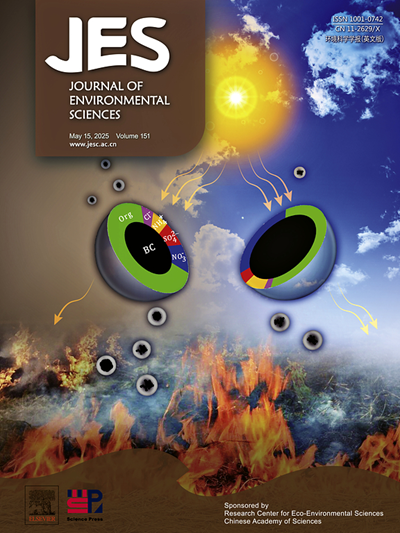魏德曼芽孢杆菌ES2-45多途径高效亚硒酸盐还原和抗铬性及水稻叶面施硒生物强化
IF 5.9
2区 环境科学与生态学
Q1 ENVIRONMENTAL SCIENCES
引用次数: 0
摘要
微生物亚硒酸盐(Se(IV))还原成元素硒纳米粒子(SeNPs)和铬酸盐(Cr(VI))修复构成有效的解毒过程。菌株wiedmannii ES2-45可在14 h内将5 mmol/L Se(IV)还原为SeNPs,在36 h内将1 mmol/L Cr(VI)还原为SeNPs。蛋白质组学分析和qRT-PCR显示,还原Se(IV)的酶包括二硫醇氧化还原酶(DsbA)、Fe-S生物合成结构域蛋白(Fes)、醛糖-6-磷酸还原酶(Aldo)和芽孢杆菌硫醇(BSH)。异源表达进一步证实了三个基因的Se(IV)还原功能,增强了对Se(IV)和Cr(VI)的抗性。此外,硒(IV)处理与对照的细胞内和细胞外每生物量BSH浓度的差异表明,BSH有助于硒(IV)的减少。利用菌株ES2-45合成的SeNPs进行叶面喷施,获得了硒强化水稻。据我们所知,DsbA和Aldo还原酶首先被证实在Se(IV)还原和Cr(VI)抗性中起作用。重要的是,将B. wiedmannii ES2-45作为SeNP合成、硒生物强化和重金属生物修复的高效细菌是一种很有前景的策略。本文章由计算机程序翻译,如有差异,请以英文原文为准。
Efficient selenite reduction and chromium resistance by multiple pathways in Bacillus wiedmannii ES2-45 and Se-biofortification in rice by foliar application
Microbial selenite (Se(IV)) reduction to elemental selenium nanoparticles (SeNPs) and chromate (Cr(VI)) remediation constitute effective detoxification processes. The strain Bacillus wiedmannii ES2-45 can efficiently reduce 5 mmol/L Se(IV) into SeNPs over 14 h and 1 mmol/L Cr(VI) within 36 h. Proteomic analysis and qRT-PCR revealed that reductases, including dithiol oxidoreductase (DsbA), Fe-S biosynthesis domain-containing protein (Fes), and aldose-6-phosphate reductase (Aldo), and bacillithiol (BSH) were involved in Se(IV) reduction. Heterologous expression further confirmed the Se(IV)-reducing function of three genes and enhanced the Se(IV) and Cr(VI) resistance ability. Moreover, the difference between Se(IV) treatments and controls both intra- and extra- cellular BSH concentration per biomass indicated that BSH contributes to Se(IV) reduction. Selenium-fortified rice was obtained by foliar spray of SeNPs synthesized by the strain ES2-45. To the best of our knowledge, DsbA and Aldo reductase were firstly verified for the role in Se(IV) reduction and Cr(VI) resistance. Importantly, it is a promising strategy that B. wiedmannii ES2-45 is served as an efficient bacterium for SeNP synthesis, selenium biofortification and heavy metal bioremediation.
求助全文
通过发布文献求助,成功后即可免费获取论文全文。
去求助
来源期刊

Journal of Environmental Sciences-china
环境科学-环境科学
CiteScore
13.70
自引率
0.00%
发文量
6354
审稿时长
2.6 months
期刊介绍:
The Journal of Environmental Sciences is an international journal started in 1989. The journal is devoted to publish original, peer-reviewed research papers on main aspects of environmental sciences, such as environmental chemistry, environmental biology, ecology, geosciences and environmental physics. Appropriate subjects include basic and applied research on atmospheric, terrestrial and aquatic environments, pollution control and abatement technology, conservation of natural resources, environmental health and toxicology. Announcements of international environmental science meetings and other recent information are also included.
 求助内容:
求助内容: 应助结果提醒方式:
应助结果提醒方式:


